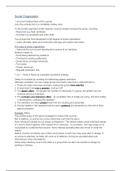Social Organisation
= structural relationships within a group
(very few animals live in a completely solitary way)
To be socially organised certain features must be divided amongst the group, including:
- Resources e.g. food, territories
- Activities e.g. protection and other skills
Two groups that have developed a high degree of social organisation
= insect (termites, bees) and mammals (wild dogs and naked mole rates)
The value of social organisation
= Improves the survival and reproductive success of an individual
Making it easier to:
- Avoid being attacked by predators
- Find food by hunting collectively
- Divide labour amongst individuals
- Find mates
- Protect resources
- Regulate population size
Type 1: Herd or flocks as a predator avoidance strategy
Safety is increased by avoiding and defending against predators.
Although a predator can see a large group more easily, less prey is captured due to:
1. There are many more eyes and ears, making the group more watchful.
2. A large heard can mob a predator, scaring it off.
3. The dilution effect – the greater the number of individuals in a group, the greater survival
. chances are of an individual.
4. The confusion and distraction effect – as a predator tries to single out a prey, the herd scatter
. in all directions, confusing the predator.
5. The members of a flock protect those that are moulting and vulnerable.
6. During migration, the inexperienced are given guidance and protection by the herd or flock
. against predation.
Example: Zebra
They exhibit many of the above strategies to ensure their survival.
But in addition, no animal has a more distinctive coat than the zebra.
Each individual’s stripes are as unique as fingerprint. The vertical stripes cause individual zebras
of a herd to blend together when viewed from a distance. To a predator, the huge shape is not
recognised as a potential food source. Some disease spreading flies also chose to avoid the
stripes.
Zebras must be constantly wary of lions and hyenas. A herd has many eyes alert to danger. If
an animal is attacked, its family will come to its defence circling the wounded zebra and
attempting to drive off predators.
Zebra sleep standing up and only when in a group that can alert one another to danger by
barking or whining.
, Type 2: Packs as successful hunting strategy
The African Wild or Cape Hunting dogs are highly social animals with complex methods of
communication, such as touch, actions or vocalisations, that keep the group functioning
together, especially when hunting.
Physical adaptations:
1. Their coats are a mottled combination of tan, black and white, with each individual having a
. unique pattern, allowing for camouflage.
2. Their long legs and large lungs help them run long distances without tiring.
3. They have very a very strong jaw and teeth for ripping the flesh and allowing it to grab and
. hang on to its prey.
4. They have large, rounded ears, which help to keep track of pack members by picking up long
. distance vocal calls.
Hunting:
- They have one of the highest success rates (80%) of any predator species in Southern Africa.
- They hunt in a very efficient manner, with the needs of the entire pack being satisfied.
- They hunt at dusk or dawn in very close-knit packs of up to 15 adults.
- Their prey = antelope, zebra and warthog
- After detecting prey, by sight or sound, they chase it. They have a very high endurance and
. normally run until the prey tires.
- When the prey tires they immobilize it by one dog grabbing its tail and another its mouth. The
. rest of the pack quickly and efficiently kill the prey.
- The whole pack shares in the kill, with the youngest feeding first. They are the only carnivorous
. species to do this.
- The dominant female, the pups and those who are unable to hunt (sick, old, injured) are left at
. the den and are fed on regurgitated meat.





